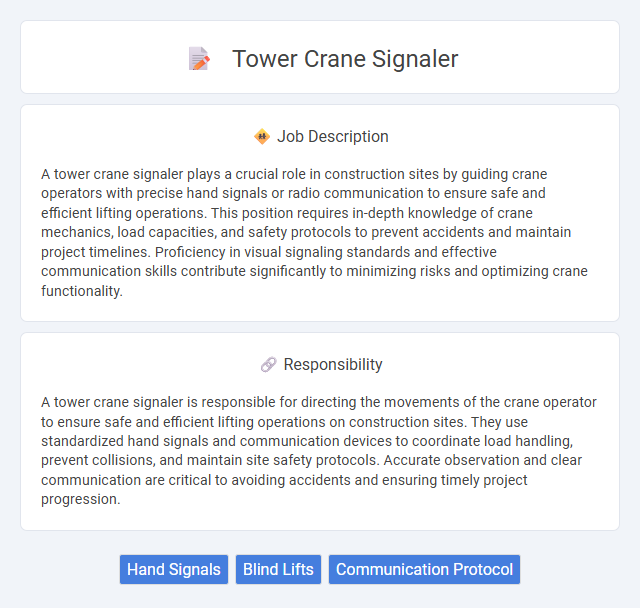
A tower crane signaler plays a crucial role in construction sites by guiding crane operators with precise hand signals or radio communication to ensure safe and efficient lifting operations. This position requires in-depth knowledge of crane mechanics, load capacities, and safety protocols to prevent accidents and maintain project timelines. Proficiency in visual signaling standards and effective communication skills contribute significantly to minimizing risks and optimizing crane functionality.
Individuals with sharp attention to detail and strong communication skills are likely suitable for a tower crane signaler job, as the role demands precise coordination and clear signaling to ensure safety. Candidates who are comfortable working at heights and possess the ability to remain calm under pressure may find themselves well-matched to the responsibilities of directing crane movements on construction sites. Those with physical stamina and good spatial awareness may also have a higher probability of succeeding in this role.
Qualification
A Tower Crane Signaler must possess strong knowledge of hand signals and communication protocols to ensure safe crane operations. Certification in rigging and signaling, along with a thorough understanding of construction site safety regulations, is essential. Experience working closely with crane operators and a valid safety training certificate like OSHA 10 or 30 improve job qualifications significantly.
Responsibility
A tower crane signaler is responsible for directing the movements of the crane operator to ensure safe and efficient lifting operations on construction sites. They use standardized hand signals and communication devices to coordinate load handling, prevent collisions, and maintain site safety protocols. Accurate observation and clear communication are critical to avoiding accidents and ensuring timely project progression.
Benefit
A tower crane signaler likely enhances construction site safety by effectively communicating crane movements, reducing the probability of accidents. This role may increase overall project efficiency, helping to keep timelines on track and minimize costly delays. Skilled signalers could also improve teamwork and coordination, contributing to smoother operations and potentially higher job satisfaction among crew members.
Challenge
A Tower crane signaler job likely involves significant challenges related to precise communication under high-pressure conditions, where misinterpretation can lead to safety risks and operational delays. The role probably demands constant vigilance and the ability to read and respond to dynamic environments quickly, making it mentally and physically demanding. There is a strong probability that signalers must manage stress effectively while coordinating complex lifting operations in potentially hazardous weather and site conditions.
Career Advancement
Tower crane signaler jobs provide critical experience in construction site coordination and safety protocols, essential for advancing to crane operator roles. Mastery of hand signals, radio communication, and safety standards enhances employability and opens pathways to supervisory positions or specialized equipment operation. Developing expertise in site logistics and hazard identification supports career growth within the construction and heavy machinery industries.
Key Terms
Hand Signals
A tower crane signaler plays a critical role in ensuring safe and efficient crane operations by using standardized hand signals to communicate with the crane operator. Mastery of precise gestures such as stop, hoist up, hoist down, swing, and emergency signals is essential to prevent accidents and maintain workflow on construction sites. Proficiency in internationally recognized signal codes enhances coordination, minimizes miscommunication, and supports compliance with occupational safety regulations.
Blind Lifts
A tower crane signaler plays a critical role in ensuring safety during blind lifts, where the operator has no visual contact with the load. They use standardized hand signals, radios, and other communication tools to guide the crane operator accurately, preventing accidents and optimizing load placement. Expertise in interpreting load charts and environmental conditions is essential for managing the complexities of blind lifts effectively.
Communication Protocol
A tower crane signaler plays a critical role in construction safety by maintaining clear, standardized communication with the crane operator using hand signals, radios, or other agreed-upon methods. Mastery of recognized signaling protocols such as the OSHA or ANSI standards ensures accurate load movement and prevents accidents on site. Effective communication protocols enable precise coordination between ground personnel and the crane operator, optimizing workflow efficiency and minimizing the risk of operational errors.
 kuljobs.com
kuljobs.com